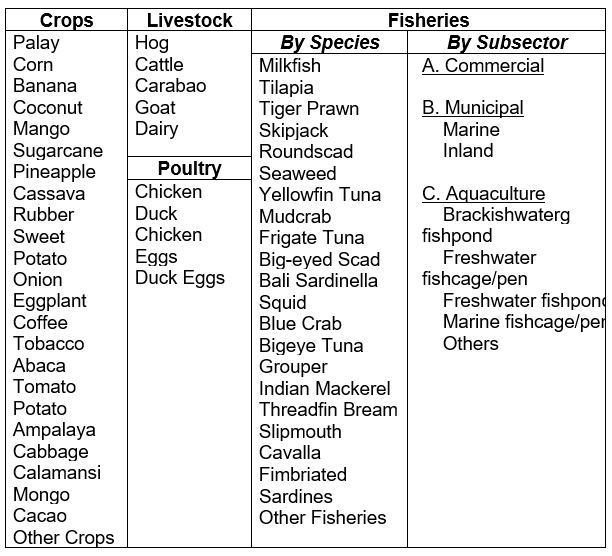I. The Introduction
This is the third of the eight (8) modular reports of the Agricultural Indicators System (AIS) which provides information on productivity of the different components of agricultural sector such as crops, livestock, poultry and fisheries production.
II. Data Sources
| Data and Indicators | Source Agency |
|
Philippine Statistics Authority |
Commodities Covered

III. Methodology
Indices of area harvested of agricultural crops

Growth rates of area harvested of agricultural crops

Indices of production of agricultural crops

Growth rates of production of agricultural crops

Indices of yield of agricultural crops

Growth rates of yield of agricultural crops

IV. Concepts and Definition of Terms
Crop Production – refers to the quantity produced and actually harvested for a particular crop during the reference period. It includes those harvested but damaged, stolen, given away, consumed, given as harvester’s share, reserved, etc. Excluded are those produced but not harvested due to low price, lack of demand and force majeure or fortuitous events, etc.
Area Harvested – refers to actual area from which harvests are realized. This excludes crop area which is totally damaged. It may be smaller than the area planted. In crops statistics, this applies to temporary crops.
Area Planted – refers to actual physical area planted. This generally applies to area reported for permanent crops and multi-harvest temporary crops.
Yield – refers to the average production per unit area. It is an indicator of productivity derived by dividing total production by the area harvested.
Indices of area harvested of agricultural crops – this measure provides an indicator of the annual changes in area harvested relative to a given base year. This would show the differential changes among the different crops which could reflect the shifts in the utilization of the country’s arable land.
Growth rates of area harvested of agricultural crops – denote year-to-year variation or annual percentage change in area.
Indices of production of agricultural crops – measure the relative changes in production of different crops in a given year compared to a base year. The production index reflects the relative pace of production changes among these agricultural commodities.
Growth rates of production of agricultural crops – denote the yearly changes in production.
Indices of yield of agricultural crops – reflect the changes in production per hectare of agricultural crops in specific year compared to a base year.
Growth rates of yield of agricultural crops – provide a measure of the changes in agricultural productivity. A positive change will indicate improvement in productivity while a negative growth will reflect deterioration in productivity.
Livestock Production (Operational Definition) - the number of locally-raised animals disposed for slaughter which include animals shipped-out for slaughter (in “head” and in “liveweight equivalent”).
Poultry - is a collective term for all domesticated avian for the purpose of food consumption or, the carcass of such avian/dressed processed for human consumption. Fowl is a term used to refer to a specific group of avian sharing common anatomical characteristics, e.g. chicken and duck.
Volume of meat production – aggregate volume of meat recovered from domestic production including meat equivalent of imported live animals. This excludes meat equivalent of exported live animals and condemned meat from slaughter houses.
Milk production – amount of milk produced by dairy animals including suckled or fed to calving to the dry period.
Indices of volume of livestock and poultry production – reflect the changes in the volume of production of livestock and poultry in a given year relative to a base year.
Growth rates of volume of livestock and poultry production – measure the rate of growth of production of each component of the livestock and poultry sector.
Volume of fisheries production – a.) Commercial Fisheries – quantity of fish catch unloaded in the commercial fish landing centers; b.) Marine Municipal Fisheries – quantity of fish catch unloaded in the municipal fish landing centers; c.) Inland Municipal Fisheries – quantity of species caught by inland fishing households; d.) Aquaculture – quantity of species harvested in the aquafarms.
Indices of volume of fisheries production – show the changes in the volume of fisheries production by subsector and species in a given year relative to a base year.
Growth rates of volume of fisheries production – measure the year-to year variation in the volume of fisheries production by subsector and species.
Commercial fisheries – is one of the fisheries subsectors that covers fishing operations in marine waters beyond 15 kilometers from the shoreline by fishing boats with more than three (3) gross tons.
Municipal fisheries - is one of the fisheries subsectors that covers fishing operations in marine waters beyond 15 kilometers from the shoreline using fishing vessels of three (3) gross tons or less, or fishing not requiring the use of fishing vessels.
Municipal waters – include not only streams, lakes, inland bodies of water and tidal waters within the municipality which are not included within the protected areas as defined under Republic Act No. 7586 (The NIPAS Law), public forest, timber lands, forest reserves or fishery reserves, but also marine waters included between two lines drawn perpendicular to the general coastline from points where the boundary lines of the municipality touch the sea at low tide and a third line parallel with the general coastline including offshore islands and 15 kilometers from such coastline. (Republic Act No. 8550, An Act Providing for the Development, Management and Conservation of the fisheries and Aquatic Resources, Integrating All Laws Pertinent Thereto, and for Other Purposes)
Inland fisheries – is one of the fisheries subsectors that covers fishing operations performed in inland bodies of water using fishing vessels of three (3) gross tons or less or fishing not requiring the use of fishing vessels.
Aquaculture – fishery operations involving all forms of raising and culturing of fish and other fishery species in fresh, brackish and marine water areas.
Fishpond – refers to a land-based type of aquafarm; a body of water (artificial or natural) where fish and other aquatic products are cultured, raised, or cultivated under controlled conditions.
Fish pen – refers to an artificial enclosure constructed within a body of water for culturing fish, fishery/aquatic resources made up of bamboo poles closely arranged in an enclosure with wooden material, screen or nylon netting to prevent escape of fish.
Fish cage – a stationary or floating fish enclosure of synthetic net wire/bamboo screen or other materials set in the form of inverted mosquito net (“hapa” type) with or without cover with all sides either tied to poles staked to the water bottom or with anchored floats for aquaculture purposes.
Oyster/mussel farm – an aquafarm involved in the cultivation of oyster/mussel in shallow brackish or marine areas by any method for production purposes.
Seaweed farm – an aquafarm involved in the cultivation of seaweed in suitable water areas by any method with appropriate intensive care for production in commercial quantities.
Brackish water environment – refers to mixed seawater and freshwater and salinity varies with the tide. Examples are estuaries, mangroves, and mouth of rivers where seawater enters during high tide.
Freshwater environment – refers to water without salt or marine origin. It is pure fresh water. Examples of no mixture of seawater (Laguna de Bay, Taal Lake, Candaba Swamps, Liguasan Marsh and rivers, canals, dams and paddy fields and rice fields.
Marine water/Seawater environment – refers to inshore and open waters and inland seas in which salinity generally exceeds 20 percent.
Percentage Point Difference – refers to the unit difference of two percentages (current year index less base year index, where base year=100)
V. Dissemination of Results
| Title | Schedule of Release |
| Output and Productivity | July of the Current Year |
Statistical tables, infographics, and modular report are included in the web release.
VI. Citation
Philippine Statistics Authority. (2022). Technical Notes on Output and Productivity. https://psa.gov.ph/statistics/technical-notes/167201
VII. Contact Information
Ms. Manuela S. Nalugon
(Supervising Statistical Specialist)
Officer-in-Charge
Agricultural Accounts Division
(02) 8376-1954
m.nalugon@psa.gov.ph
For data request, you may contact:
Knowledge Management and Communications Division
(02) 8462-6600 loc. 820
info@psa.gov.ph | kmcd.staff@psa.gov.ph

